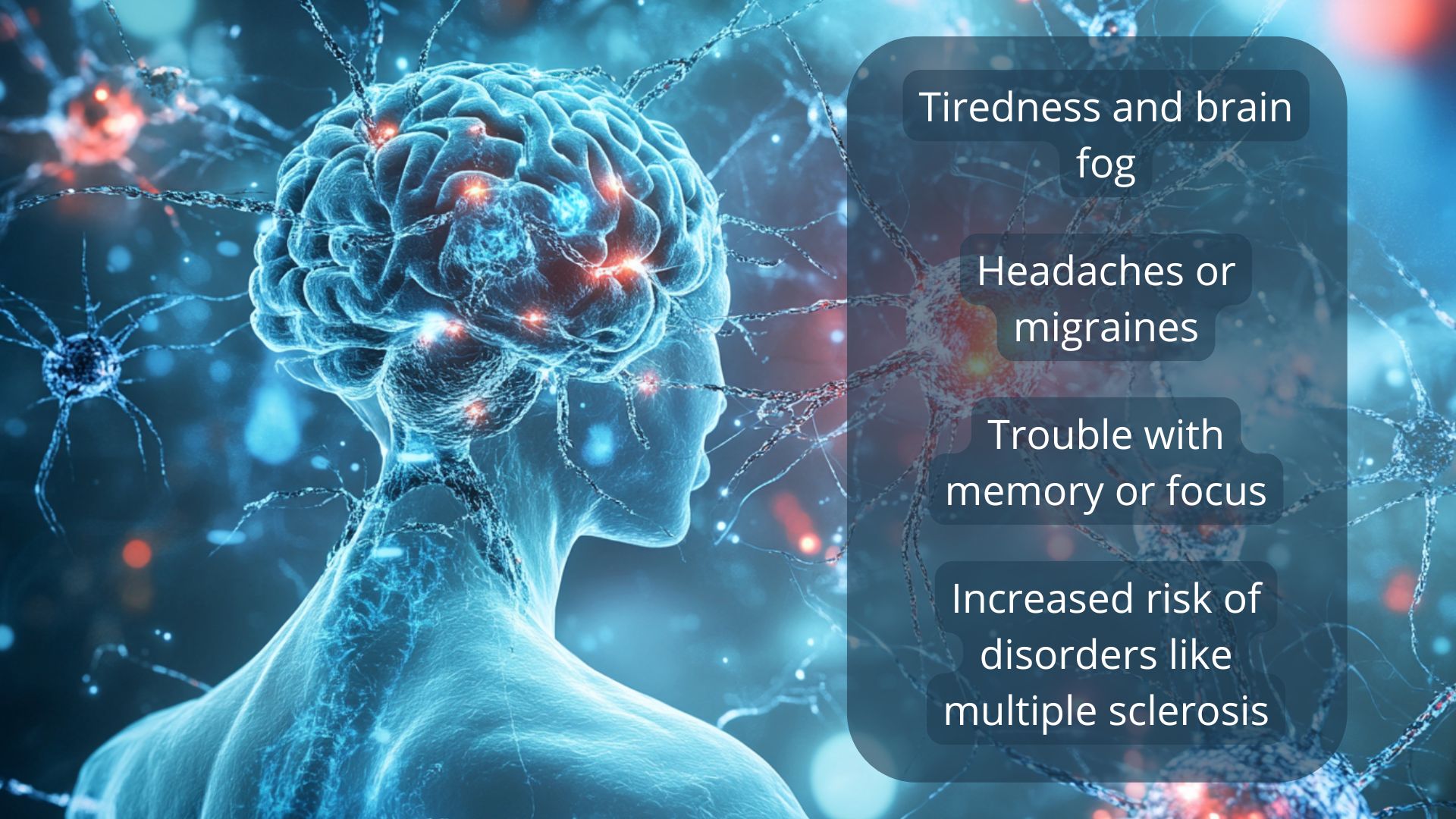Many people wonder if chronic viral infections (CVIs) can lead to neurological disorders. The answer isn’t simple. However, growing research shows a clear link between the two. When viruses are in the body for a long time, they can cause trouble not just for your immune system but also for your brain. This connection happens because viruses can interact with your body in ways that disrupt normal brain function. Let’s break it down.
Viruses, like those causing herpes, hepatitis, or even some common colds, sometimes stick around instead of being cleared out quickly. These CVIs can quietly affect your body including your brain. They may trigger inflammation, stress your immune system, and even directly harm brain cells. This can lead to neurological disorders. These are conditions that affect the brain, nerves, and spinal cord. Examples include multiple sclerosis, Parkinson’s disease, and even milder issues. These include headaches or memory problems.
The immune response plays a big role here. Your body fights viruses by sending out immune cells to attack them. But when the virus doesn’t go away, this fight can go on too long. It causes damage to healthy tissues, including in the brain. This mix of viral activity and immune overreaction can set the stage for serious health issues. In this article, we’ll explore how these infections persist. We will talk about how they affect the brain and what you can do about it.
How Chronic Viral Infections Persist in the Body
Viral persistence is when a virus hides in the body. It evades the immune system even after the initial infection seems to fade. Some viruses, like herpes simplex or HIV, are experts at this. They can “hide” in cells. They stay dormant for months or years, only to reactivate later. This sneaky behavior makes it hard for your body to get rid of them completely.
Here’s how viral persistence works:
- Hiding in Cells. Viruses can tuck away in places like nerve cells or immune cells. This way, they can avoid detection.
- Weak Immune Clearance. Sometimes, the immune system can’t fully eliminate the virus, letting it linger.
- Reactivation. Stress, illness, or a weakened immune system can wake the virus up. And this can cause new symptoms.
When a virus persists, it keeps the body on high alert. The immune response kicks in, releasing chemicals to fight the invader. Over time, this constant battle can wear down the body. For the brain, this is problematic. Persistent viruses can cross into or affect the nervous system. It leads to inflammation or damage. This ongoing stress may harm neural health. This increases the risk of neurological disorders like chronic fatigue syndrome or even more severe conditions. Understanding viral persistence is key to seeing why these infections can have such a long-lasting impact.
Neuroinflammation and Immune System Overdrive
When a virus lingers, the body’s immune response doesn’t stop. This can lead to neuroinflammation. This is a state where the brain and nervous system become inflamed. Inflammation is the body’s way of fighting threats. However, when it goes on too long, it becomes harmful. Here’s how this happens.
The immune system releases proteins called cytokines to attack the virus. In CVIs, these cytokines keep flowing, and some can reach the brain. This triggers neuroinflammation. In the brain, cells and tissues swell or get irritated. While a short burst of inflammation helps fight infection, chronic inflammation can damage healthy brain cells. It can disrupt signals between nerves and cause problems.
Some effects of neuroinflammation include:
- Tiredness and brain fog
- Headaches or migraines
- Trouble with memory or focus
- Increased risk of disorders like multiple sclerosis
This “overdrive” of the immune system can wear out the brain’s defenses. Over time, neuroinflammation from persistent viruses may contribute to serious neurological disorders. Scientists are still studying exactly how this works. However, the link between a hyperactive immune response and brain issues is clear.
Long-Term Effects on Cognitive Function
One worrying outcome of CVIs is cognitive decline. This means a gradual loss of mental abilities like memory, focus, and problem-solving. When viruses persist and cause ongoing neuroinflammation, the brain takes a hit. Let’s look at how this happens.
Prolonged immune activation from a virus can stress brain cells. The inflammation and chemicals from the immune response can damage neurons, the cells that carry signals in the brain. Over time, this damage adds up. People might notice:
- Forgetting names or events
- Struggling to concentrate
- Slower thinking or decision-making
Cognitive decline doesn’t always mean severe conditions like dementia. It can start small. This might include mild confusion or trouble multitasking. For example, some people with CVIs like hepatitis C or HIV report “brain fog.” It is a fuzzy feeling that makes daily tasks harder. Doctors suggest that viral persistence in the body can slowly chip away at brain function. This is especially true if inflammation isn’t controlled. Protecting the brain from this long-term stress is crucial to avoid lasting cognitive decline.
The Role of the Central Nervous System in Chronic Infections
The central nervous system is made up of the brain and spinal cord. This system serves as the body’s control center. It manages thoughts, movements, and senses. But chronic viral infections can target or affect this vital system, leading to problems. Here’s how.
Some viruses can directly invade the central nervous system. For example, the herpes virus or West Nile virus can cross into the brain, infecting cells and causing inflammation. Even if a virus doesn’t directly enter the brain, the ongoing immune response to viral persistence can still harm it. The inflammation and stress can disrupt how the central nervous system works, leading to symptoms like:
- Muscle weakness
- Tingling or numbness
- Seizures or tremors
This damage might contribute to neurological disorders. For instance, some studies link CVIs to conditions like encephalitis (brain inflammation) or even Parkinson’s disease. The central nervous system is sensitive. When CVIs disturb this system, the effects can be serious and long-lasting. Protecting this system means fighting the root infection and reducing inflammation.
Diagnosing and Managing Virus-Linked Neurological Conditions
Figuring out if a neurological disorder comes from CVIs isn’t easy, but it’s critical. Doctors use several methods to diagnose these conditions. Here’s a look at the process:
- Blood Tests. Test for evidence of viral infections or immune activity.
- Imaging. MRI or CT scans can reveal brain inflammation or damage.
- Spinal Tap. Analyzes cerebrospinal fluid for viruses or inflammation markers.
- Symptom Tracking. Doctors document symptoms like headaches, memory loss, or muscle issues.
Symptoms vary widely. Some people feel mild fatigue or confusion, while others face severe issues like seizures or paralysis. Once diagnosed, managing these conditions involves a few steps:
- Antiviral Drugs. These medications target viral replication.
- Anti-Inflammatory Meds. These reduce neuroinflammation to protect the brain.
- Therapy. Physical or cognitive therapy helps manage cognitive decline or weakness.
- Lifestyle Changes. Rest, a healthy diet, and stress relief support the immune response.
Early detection and treatment are crucial in managing health issues effectively. By identifying a problem at its onset, doctors can intervene promptly. They can prevent further complications and minimize damage to critical systems. This proactive approach not only stops the progression of the condition. It also enhances the patient’s overall well-being. Timely action can lead to better outcomes, reducing the severity of symptoms and improving long-term prognosis. Moreover, early intervention often allows for less invasive treatments. They can be less taxing on the body and mind. Ultimately, catching issues early empowers doctors to tailor strategies that significantly boost quality of life, ensuring patients maintain greater functionality and comfort in their daily lives.
Future Research and Prevention Opportunities
Scientists are working hard to learn more about how CVIs lead to neurological disorders. Ongoing research aims to uncover:
- How viruses hide and cause viral persistence
- Ways to stop neuroinflammation before it harms the brain
- Links between infections and specific issues like cognitive decline
Exciting studies are exploring new antiviral drugs, vaccines, and therapies to moderate the immune response. For example, researchers are testing treatments to target viruses in the central nervous system without causing side effects. Others are looking at how diet, exercise, and sleep might strengthen the body against these infections.
Prevention is also a big focus. Here are some practical steps:
- Get vaccinated against viruses like flu or hepatitis
- Practice good hygiene, like handwashing, to avoid infections
- Boost your immune system with a balanced diet and rest
- See a doctor early if you have symptoms like long-lasting fatigue or brain fog
Chronic viral infections pose significant challenges to human health particularly regarding their impact on the brain. These infections can persist in the body, often evading the immune system and causing long-term effects. Research shows they may contribute to neurological disorders. These include cognitive decline, inflammation, and neurodegenerative diseases like Alzheimer’s. By understanding the mechanisms of CVIs, we can develop targeted therapies. Advances in virology, immunology, and neuroscience are paving the way for innovative treatments. With ongoing research, we can better protect the brain, reduce the risk of neurological disorders, and improve patient outcomes. The future looks hopeful as science continues to unravel this complex issue offering new strategies to combat these persistent infections.












Please, leave your review
Write a comment: